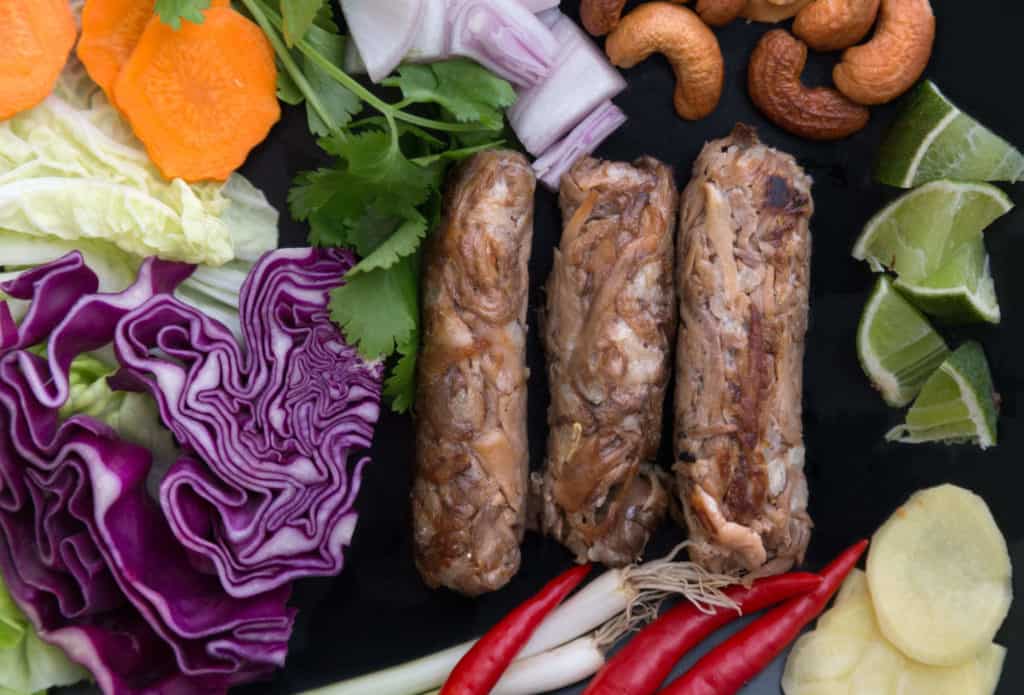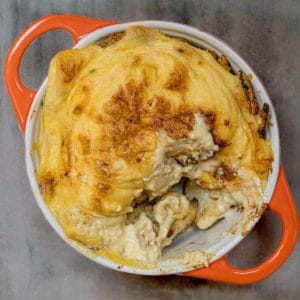I believe 2010 was the first year I visited Pun Pun, a highly regarded vegetarian restaurant in Thailand's Northern city of Chiang Mai (FYI in 2012 they used oyster sauce so if you visit it's worth asking if this is still the case). Two years later, after one bite of their fermented mushroom sausages, I plucked up the courage to beg admission to their kitchen. It was granted, and that's how I learned to make naem het (also written hed).

Naem is a preserved sausage of Northern and Northeastern origins composed of ground pork that is fermented with rice and garlic. Lactic acid generated by the fermentation process (fed by sugar and carbohydrates from rice), along with salt, inhibits growth of unwanted bacteria. What you end up with is a salty and sour sausage that is eaten in a myriad of ways – raw, grilled, deep fried, stir fried, in salads (e.g. yam naem hed khao tod), and more.

Naem hed borrows from the same basic method of fermentation, only with one major difference: this version is 100% vegan, made from mushrooms (het means mushroom in Thai – เห็ด) instead of pork. Mushrooms are shredded, steamed vigorously, wrung out, and then mixed with salt, rice, and garlic to ferment. Sometimes the mix is formed into cylindrical sausage shapes and other times bite sized portions are packed into small plastic baggies with a chilli inside.

Worth noting is the importance of spicy chillies in the preparation and consumption of these sausages. As well as acting as a preservation agent, chillies (along with ginger and plenty of raw vegetables as condiments) help to cut through the fattiness of the pork. Despite the lack of fat in the vegan mushroom based version, I have never come across them sans chilli (and if I have there are always bird's eyes served alongside). Personally I think the scuds are a must, but if you are averse to too much heat then you will still enjoy a very good meal if they are omitted.

These sausages will always ferment more successfully at higher temperatures (it's Thailand, after all) with moderate humidity.
In addition to bird's eye chillies, sliced ginger, and uncooked vegetables (especially cabbage), there are a few other ingredients you should consider adding to the plate in order to enhance this dish: raw shallots, fresh lime, roasted peanuts and/or deep fried cashews, and sprigs of coriander.
📖 Recipe
Naem Het (naem hed) แหนมเห็ด – vegan Thai fermented mushroom sausages
Ingredients
- 225 grams oyster mushrooms
- Scant ¼ teaspoon salt
- 1 large clove garlic
- 15 grams cooked glutinous rice
- Pinch of sugar
Instructions
- Before starting, ensure all utensils and bowls you use are scrupulously clean. Hands too!
- Cut or tear the oyster mushrooms lengthwise (down the lines of the gills) into thin slivers. Pile them into a steamer and steam for 20-30 minutes on a fairly high heat. They will be fine and stringy, but tough, when finished. Allow to cool enough to handle.
- While the mushrooms are cooling pound the salt and garlic to a fine paste with a pestle and mortar.
- Rinse the cooked rice to break up any clumps and squeeze or press it to remove excess water. Pop the rice into the mortar and pound lightly with the garlic paste. The goal isn't to make it into a paste, but to break the grains down only slightly.
- Once the steamed mushroom shreds have cooled you must rid them of excess moisture by wringing them out in muslin or another thin cloth. Pressing in small portions will make this easier. Wring as much liquid out as possible (tip: save the liquid and use as a replacement for vegetable stock in recipes).
- Combine the rice and garlic paste with the mushrooms in a bowl and knead with your hands to combine. Divide them into four portions and wrap them in squares of cling film to form small sausage shapes.
- Remember, these would be fermented at temperatures around or above 30 degrees Celsius in Thailand, so find a warm spot to leave them to ferment. In the winter I often wrap them in a tea towel and leave them under a radiator. Another option is an airing cupboard. In ideal conditions these could be done in 24 hours, but I find anywhere from 3-7 days is right in the English climate. They should taste salty, slightly sour, and pungent from garlic when done.
- You can eat them raw or fry them briefly, which is my preference because it imparts some oiliness that pairs well with the sides you should consume the sausages with: deep fried cashews and/or peanuts, raw cabbage, thinly sliced ginger, bird's eye chillies, chopped shallots, fresh lime, and sprigs of coriander.






Kim says
Ive been wanting to try this recipe for a while and decided this was a good weekend for it. Is it really only 15 grams of rice?
Thanks for this blog. I love the variety here.
Kip says
Hi Kim,
Thank you for your kind words! Yeah, the quantity of rice really isn't much. The measure can afford some variability with using more rice too, but certainly works with as little as that. I've had versions of these sausages that are very dense with rice and they tend to be too mushy when cooked later on, so my preference is for less.
Peggy says
Have you tried packaging the entire mix as a single sausage?
I've got a double batch fermenting now, using portobellos as there were no oysters when I went shopping. I'll let you know how they turn out.
Next tisme I'll try stuffing them into a sausage casing for a tidy presentation.
Kip says
I've tried it with sausage casing but haven't had much luck (the casing always bursts on me). They are a little bit crumbly so I think that would be the only way to encase it as a single sausage though. Let me know if you ever do that! And also how it comes out with portobellos, which I've never used for these.
Lisa says
I would like to make these but am concerned about the fermentation process.. I don’t know if I have a warm enough place in my kitchen for this.. what temperature is good for them in Fahrenheit? Or can they be put in direct sunlight. Also how can you tell if they go bad? Thank you.
Kip says
Hi Lisa,
Warmth is definitely a requirement. I've not tried to make them at temperatures below 22c (and even that is slow going). Another method would be to seal them and use a dehydrator for consistent heat. I have never made them in direct sunlight. If they go bad mould will be apparent.
Kate says
Hi Kip, thanks for your well researched recipe. I wondered if you could tell me how long they will keep in the fridge? I am fermenting mine in a dehydrated at 30 degrees for 24 hrs (perhaps longer they are still in there!)
Kip says
Hi Kate,
They have a pretty reasonable shelf life. I've got some from a few weeks ago still waiting to be used as a congee topping...
Deniz UÇAR says
Thanks for the recipe. We wrapped them in squares of cling film and now waiting for fermentation. Our question, is we covered the entire sausage with film and no air can diffuse. Also, no water can escape from now. Fermentation should be oxygen free process as I know but is there any trick here?
Hope you answer quickly as we finished the process :/
Kip says
Hi Deniz,
I don't fully understand your question. Do you mean you are afraid air will enter the parcel? In Thailand the ends are tied with rubber bands (e.g. in this video https://www.youtube.com/watch?v=CMGXJPeFFic), so you could try that.
alice says
Hi there, I wondered if i could preserve these shred in a large mason jar?
Kip says
High there, sorry it took me awhile to respond. I've not tried this, but if I did I'd push the shredded mushroom down firmly in the jar and then cover the top of the mushrooms with some cling film (as well as the lid on the jar).
I reserve the right to improve malicious and trollish comments.